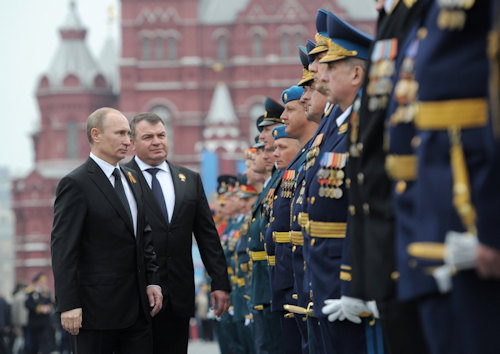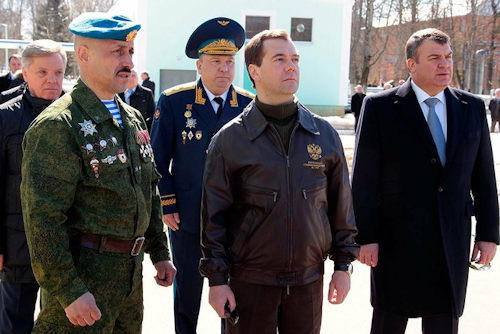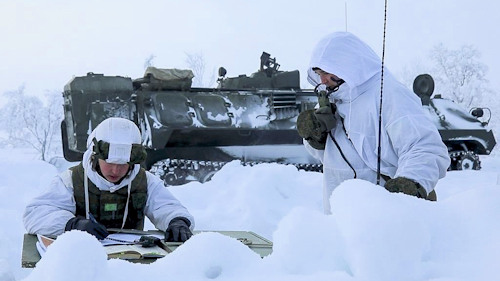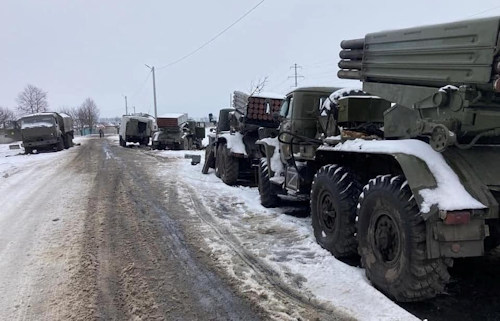The analysis carried out on the relations of force between Russia and Ukraine on the military level (including the estimate of the types of weapons systems, not only the numbers of men and vehicles, of course) referring to the days immediately preceding the invasion, made an estimate of the conquest of Kiev in 4-5 days and the occupation of the country in about three months, in consideration of the geographical extension of the same, of the relative distribution of k-terrain (Odessa, Karchov, Chernihiv, Mariupol and, in perspective, Vynnitsya and Lviv) and the resistance encountered, opposed by the armed forces and the people of Ukraine.
The first fact that emerges is that after five days Kiev is besieged, bombed, attacked, but has not yet fallen into the hands of the Russians. On the tactical level, this "setback" represents a defeat for the Russian armed forces.
Don't be fooled, Moscow is still capable of winning this battle. The last three days of fighting, however, hint at vulnerabilities and gaps in the Russian army which, following the reorganization implemented after the conflict with Georgia in 2008, should have been filled.
The recent structural reforms of the Russian armed forces do not appear to have been sufficient for the tasks they are called upon to perform. Furthermore, it seems that the Russians are not able to exploit the advantages they possess in terms of men, means and materials compared to their opponents.
Let's take a step back and see, in practice, what were the reforms implemented by the Kremlin for a rationalization of the military instrument.
In 2007, with the appointment of the economist Anatolij Serdjukov as Minister of Defense, a process of substantial reform was initiated (novyy oblik - “new form”) and partly built over the next five years. Compared to his predecessors, who all came from the Armed Forces or the Security Apparatus, Serdyukov's civilian training, paradoxically, may have represented an advantage in the reform action implemented, as it is less sensitive to the influence ofestablishment military. His position, already strengthened by a "purge" among the military leaders carried out in 2007, was consolidated through a series of drastic measures:

- Elimination of mass mobilization, typical of the Soviet model, with the abolition of "framework units" and the transfer of their personnel into active duty units, capable of rapid deployment in the event of conflict, in line with the objective set by the then president Dmitry Medvedev , to have units in "permanent operational readiness" by 2020.
- Creating smaller units, as happened with the reforms implemented in the Western military after the end of the Cold War, which allowed a faster and more flexible response for use in small-scale regional conflicts. The plan was to structure the army on divisions with a strength of about 10.000 men, each capable of being divided into autonomous brigades of about one third of the total strength. A restructuring program was also drawn up for the aeronautics.
- More dynamic command structures, given the fading of the needs of mass mobilization. Many departments of the Defense General Staff and the General Staff of the individual Armed Forces were suppressed or underwent a downsizing. At the same time, many warehouses were closed for the custody of the equipment for the Reserve Forces.
- Reduction in the number of senior officers, from 500.000 in 2008 to 220.000 in 2011 (in Serdyukov's initial design it was expected to reach 150.000), while establishing an organic level of 200.000 non-commissioned officers, to improve discipline and training.
- Creating a leaner chain of command and more effective coordination, replacing the six Soviet-era Military Districts with four in four Military Districts, responsible for all military forces and resources (land, air and sea) present within them: the Western District, the Southern District, the Central District and the Eastern District, to which the Arctic Joint Forces Strategic Command was added from January 1, 2021 December 2014. Each of these Commands has an operations room that directs the land, air and naval forces in their Region, activating a shorter chain of command and control where orders no longer need to be approved by Moscow.
- Considerable increase in defense resources,1 with the 2010 State Armaments Program, referring to the period 2011-2020, which provides for a significant increase in financial resources allocated for this purpose and aims to increase the percentage of advanced weapon systems from 20% 70%, in line with the NATO Armed Forces.
 With the decree of 14 July 2010 of the former president Medvedev (photo), the pre-existing six Military Districts were then grouped into four Military Districts, responsible for all the military forces and resources (land, air and sea) present within them: the District Western, Southern District, Central District and Eastern District.
With the decree of 14 July 2010 of the former president Medvedev (photo), the pre-existing six Military Districts were then grouped into four Military Districts, responsible for all the military forces and resources (land, air and sea) present within them: the District Western, Southern District, Central District and Eastern District.
Following the progressively accrued interest in the Arctic as an area of strategic value for Russia, with a presidential decree signed on 5 June 2020,2 the Kremlin further reconfigured the organization of the Military Districts, creating the Northern Military District. The peculiarity of this District is that of having absorbed the Northern Fleet, which became the reference unit of that military body and, therefore, from 1 January 2021 a command of the Russian Navy for the first time in history took over the status of Military District.3
In the last ten years, therefore, there has been much talk of the modernization and professionalization of the Russian army.
Let us dwell, first of all, on what led to the reduction of leverage and the inclusion to a greater extent of voluntary personnel.
Russia currently deploys an active-duty army of just under one million men. Of this force, approximately 260.000 are conscripts and 410.000 are contract soldiers (kontraktniki). The military service period, reduced from two years to 12 months, provides for a maximum of five months of employment time for these soldiers. Conscripts remain about a quarter of the strength even in commando units elite (spetsnaz).
From an operational point of view, anyone who has served in the military is aware that twelve months they are hardly enough to acquire the ability to simply be a rifleman or, in any case, to carry out the tasks proper to a simple soldier in the strict sense of the term. It is nowhere near enough time for an average soldier to learn the skills needed to be an effective small unit commander.
The Russians have certainly made efforts to elevate the professionalization of officers and non-commissioned officers, and this last category has historically represented a weak point of the Russian system.

Drawing a parallel between the Western and Russian systems, in the West, NCOs professionally represent the backbone and expert of an army. They are expected to be experts in their specializations and, therefore, can reasonably be regarded as good commanders of small units and, nevertheless, with their experience and ability they rise to the role of advisors to their own commanders as well as advisers to the commanders of platoon and company level.
From experience I can say of the essential advice from senior non-commissioned officers for young officers who have come to the departments, of the value of the figure of the "Corps Petty Officer" in our Army and of the respect attributed to staff sergeants nello US Army. The Russian army does not operate in this way.
A high percentage of the military who wear non-commissioned officers' degrees are little more than senior conscripts towards the end of their term. In recent years, the Russians have established an academy for the training of non-commissioned officers and, in order to have more resources to devote to improving this category, they have reduced the number of officers; the results, however, were not sufficient to address the shortcomings of leadership of the army.
Let us now analyze the Russian failures at an operational and tactical level. It should be emphasized once again that the Russian armed forces, due to their relative weight in terms of men and materials, are still capable of winning this war. But it is becoming increasingly evident that their operational and tactical choices have not made the task easy for them.
First of all, it must be said that in order to get rid of the threat posed by the enemy's air defenses, the Russians have organized a vigorous and sustained “Suppression of Enemy Air Defenses” (SEAD) campaign. Despite the forces deployed from Moscow have gained air superiority over Ukrainian airspace, Ukrainian anti-aircraft batteries are still taking a toll on the Russian air force. It is evident that the Russians underestimated the Ukrainians' ability and determination to counter their incursions.

The situation was further complicated with the decision to launch the land offensive along a series of avenues of approach coming from different directions (north, east and south) quite distant from each other. This has created an expansion of the command and control system, making it certainly not easy. This choice, at least in the early stages of this campaign, makes coordination between the units that have obvious problems supporting each other extremely difficult.
Until they get very close to the capital, Russian units moving north of Crimea are unable to complement the efforts developed by Russian armored columns advancing towards Kiev from the east. In turn, the troops converging on Kiev from Belarus are unable to intervene against the Ukrainians who defend the Donbass, also in the eastern part of the country. With the progression deep into the Ukrainian territory this situation may change, but the adopted device has undoubtedly made the initial stages of operations more difficult. This arrangement has led to major problems with regards to logistical support.
The Russian invasion was planned to rapidly occupy large portions of territory, with the aim of paralyzing an immediate reaction by the Ukrainian armed forces and gaining immediate control of the country's key points. The Russian army has shown that it has the necessary firepower to carry out the aims of the operation, but it did not appear to be adequately supported by a logistical organization capable of sustaining, for a prolonged time, the progression of the maneuvering forces. In fact, the lengthening of the logistic arm did not make it possible to ensure the necessary support for the forces at the right time, in the right quantity, according to the required standards and in the useful points, thus nullifying the fighting capacity, which was also put to the test by the counterpart.
In the initial stages of the offensive, the Russian forces quickly achieved their first-time objectives, but the speed of action on the ground and the sabotage actions aimed at Russian convoys and the destruction of bridges and the railway network in Ukrainian territory imposed operational pauses, creating a misalignment between the maneuver and direct logistical support to the fighting forces. On Internet Several videos are available of Russian columns without petrol and blocked on Ukrainian roads.
 These facts have shown that the Russian army has the fighting power to obtain immediate results on the ground, but does not have adequate resources to ensure constant and continuous power to the maneuver.
These facts have shown that the Russian army has the fighting power to obtain immediate results on the ground, but does not have adequate resources to ensure constant and continuous power to the maneuver.
It should be borne in mind that the Russian logistical doctrine tends to exploit supplies via the railway network and the Ukrainians, masters in their own home and trained on the same doctrinal principles as former members of the Soviet Union, have sabotaged the railway sections along the exploited routes. from the enemy. All this is aggravated by a refueling capacity limited to a maximum of 45 km per day, which has not always allowed the materials consumed to be replenished in a single day.
The logistic units of the Russian armed forces have shown, at least in these phases, that they are unable to support large-scale military operations also due to the limited number of specialized means available. To the difficulties of refueling were added those of maintenance, where most of the convoys did not reach their final destinations due to the poor ability to evacuate and recover the destroyed and damaged vehicles.
I want to make a final tactical consideration. It is a fact that, in the ongoing armed conflict, the two opposing sides find themselves fighting mainly with the same weapons, well known to both, but not only: with the same technical-tactical procedures. In conventional modern warfare it is known that in order to win in a fight against steel and heavy weapons, men must get close to the enemy. If both sides are similarly equipped - in this case, they are mechanized infantry units and armored units - the side that is willing to disassemble, exit its VCCs and serve as relatively exposed infantry, will have a huge tactical advantage. .
Tanks and armored vehicles are incredibly vulnerable to modern anti-tank missiles. As the Ukrainians demonstrated, a team of two or three men armed with an anti-tank missile system Javelins or, however, with a new generation anti-tank weapon (NLAW) it can devastate a mechanized column if it is allowed to get close enough to be engaged.

The key to countering such weapons is to operate according to the criterion of combined-arms: the mechanized infantry must be willing to quickly dismount from their own vehicles, thus losing the perception of the safety offered by the protection of the vehicle, and to arrange themselves in turn to protect the advancing tanks. In this way, a reciprocal coverage relationship is established: the infantry can intervene on the anti-tank teams, while the tanks deliver fire to protect the foot soldiers. Mechanized infantry and armored troops must work with a very high synergistic relationship and this implies a relationship of great trust and a high degree of training.
The Russians appear to be "remarkably reluctant" to dismount and approach the Ukrainian defenders. Certainly there are departments that fight with determination and ability, but there are more and more frequent reports of soldiers who abandon their means, essentially deserting.
It is evident that there are big problems of morale, of training, of leadership and motivation to fight. Let's not forget what was previously said about the figures of non-commissioned officers, gods kontraktniki and conscripts.
The situation worsens when rural areas switch to urban combat, especially in large cities. Urban combat is hell. And as the Russians are learning, the fire can come from any direction. Each window, door and sewer drain is an opening that can conceal a rifle or machine gun. Roads and buildings limit the maneuvering capabilities and a well positioned tank is enough (as has happened in recent days) to annihilate an infantry unit that ventures without adequate reconnaissance and protection in a maze of streets. It seems that the Russians have learned nothing from the Battle of Grozny of the 2nd Russo-Chechen War.
To carry out a "movement and contact" operation in an urban context it is necessary to have a very high level of training for the coordination of movements and covering fire and then, it takes a lot of courage and motivation. The Russians don't seem to be good at attention to detail, and their operational and tactical failures have made an already difficult task much, much more complicated. The fear is that, in panic or anger, they will indulge in brutal and unmotivated acts.
Having overestimated their capabilities with respect to the enemy and the territory, evidently, led the Russians to commit macroscopic errors in planning.
 In conclusion, a few strategic considerations
In conclusion, a few strategic considerations
In my book "The Gerasimov Doctrine" I studied the aspects relating to the reform of the Russian armed forces and the new tactics studied and adopted by Russia. Gerasimov appears to be no longer so much in Putin's favor, but remains subject to the orders of a president who, at least in appearance, has lost touch with reality.
Putin is a KGB man and evidently regrets the procedures dating back to his formation at the time of the Cold War. He did not understand that what has been implemented through the principles of hybrid warfare in the last eight years had already made him achieve significant victories, with the annexation of Crimea to Russia and with the reputation of a "reliable ally" acquired with the operations in support of Assad in Syria.
Certainly, with his attitude, he risks alienating the support of the siloviki, who are more afraid of losing capital and profitable business opportunities than of the eastward enlargement of NATO and Europe. Military desertions are also not a good sign for Moscow. Here, then, it can become important to look at the behavior of the special forces - in particular the OMON - of the National Guard commanded by Viktor Zolotov, called to maintain order on the internal front that is being created with the anti-government protests.
On the external front, Putin, having lost confidence in his regular forces, can seriously consider sending the infamous kadirovskiy in Ukraine, the Chechen paramilitaries who fought for the cause of Moscow on their own soil.
1 F. Iacch, Within 7 full armed Russian rearmament years, http://www.difesaonline.it, 11/12/2014.
2Северный флот станет пятым военным округом России с 2021 года (The Northern Fleet will become Russia's fifth military district from 2021), 08/06/2020. https://armstrade.org.
3Here's the story of the story (The Northern Fleet of Russia received the status of a military district), 01/ 01 /2021. https://www.interfax.ru.
Photo: Russian Fed MoD / RIA Novosti / Ukraine Defense / Twitter / author












